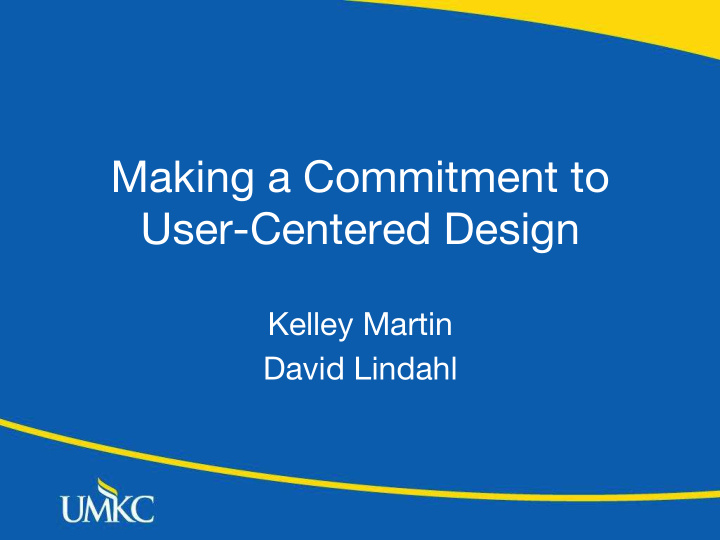



Making a Commitment to User-Centered Design Kelley Martin David Lindahl
Today’s Agenda 1. Describe A. Process B. Roles C. Product 2. Capture user needs 3. Prioritize and organize content 4. Consider heuristics 5. Design pages
1A. Describe Process • How are changes made on your library’s website? • Is your process… – Political? – Collaborative? – Creative? – User-focused?
1B. Describe Roles • User needs • Objectives • Content • Design • Programming • Usability Testing • Functional Testing • Maintenance
1C. Describe Product • Sta ff and patron perceptions • Site map drawing on a whiteboard • Language and use of jargon • Web site inventory
2. Capture User Needs What do your users need to be able to do? Sources: • Library sta ff • Users • Literature review • Usability testing
3. Prioritize and Organize Content • Prioritize – Benchmark other sites – List the content/features on your site – Prioritize the list based on documented user needs and library sta ff experience Benchmarking ¡other ¡academic ¡ library ¡websites ¡
3. Prioritize and Organize Content • Organize – Develop “buckets” of related content for major areas of your site – Focus on tasks – Balance priorities and logical groupings
3. Prioritize and Organize Content • What is a card sort? • What is the purpose? • Type of – Open – Closed – Combination
Open ¡Sort ¡
Closed ¡Sort ¡
4. Consider Heuristics • Follow convention • Be consistent • Learn by testing – Other sites – Your library site
5. Design Pages • User interface designer role • Start from documented requirements • Create wireframes, page designs
5. Design Pages • Ongoing role for design – Style guidelines help maintain consistency for improved ease of use (interface, language) – Input from meetings and issue tracking
Build a usability testing program • How many people do you need? – Organization size – Resources available – Site size • Read books and articles • Create a schedule • Practice and iterate
Education • Demonstrate the importance of testing – Make work process open – Hosting brown bag or open houses – Contributing to the larger library community • Create a new atmosphere – User needs are primary
Usability Reading Material � Krug, ¡S., ¡(2006). ¡Don't ¡make ¡me ¡think: ¡A ¡common ¡sense ¡approach ¡to ¡web ¡usability. ¡ Berkeley, ¡Calif: ¡New ¡Riders. ¡ ¡ Krug, ¡S. ¡(2009). ¡Rocket ¡surgery ¡made ¡easy: ¡The ¡do-‑it-‑yourself ¡guide ¡to ¡finding ¡and ¡ fixing ¡usability. ¡Berkeley, ¡Calif: ¡New ¡Riders. ¡ ¡ Nielsen, ¡J. ¡(1999). ¡Designing ¡web ¡usability: ¡The ¡pracPce ¡of ¡simplicity. ¡Old ¡Tappan: ¡New ¡ Riders ¡Publishing. ¡ ¡ Nielsen, ¡J. ¡(1993). ¡ Usability ¡Engineering. ¡San ¡Diego, ¡California: ¡Academic ¡Press. ¡ ¡ Neilson ¡Norman ¡Group. ¡(2005). ¡ 10 ¡Usability ¡Heurisi4c ¡for ¡User ¡Interface ¡Design . ¡ Retrieved ¡from ¡Neilson ¡Norman ¡Group: ¡hVp://www.nngroup.com/arPcles/ten-‑ usability-‑heurisPcs/ ¡ User ¡Effect. ¡(2009). ¡ 25-‑point ¡Website ¡Usability ¡Checklist. ¡Retrieved ¡from ¡User ¡Effect: ¡ hVp://www.usereffect.com/download/checklist.pdf ¡ Rubin, ¡J., ¡& ¡Chisnell, ¡D. ¡(2008). ¡Handbook ¡of ¡usability ¡tesPng: ¡How ¡to ¡plan, ¡design, ¡and ¡ conduct ¡effecPve ¡tests ¡Wiley. ¡ ¡
Contact Information David Lindahl - lindahld@umkc.edu Kelley Martin - martinkk@umkc.edu
Recommend
More recommend